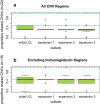Genetic and genomic stability across lymphoblastoid cell line expansions
- PMID: 30075799
- PMCID: PMC6076395
- DOI: 10.1186/s13104-018-3664-3
Genetic and genomic stability across lymphoblastoid cell line expansions
Abstract
Objective: Lymphoblastoid cell lines are widely used in genetic and genomic studies. Previous work has characterized variant stability in transformed culture and across culture passages. Our objective was to extend this work to evaluate single nucleotide polymorphism and structural variation across cell line expansions, which are commonly used in biorepository distribution. Our study used DNA and cell lines sampled from six research participants. We assayed genome-wide genetic variants and inferred structural variants for DNA extracted from blood, from transformed cell cultures, and from three generations of expansions.
Results: Single nucleotide variation was stable between DNA and expanded cell lines (ranging from 99.90 to 99.98% concordance). Structural variation was less consistent across expansions (median 33% concordance) with a noticeable decrease in later expansions. In summary, we demonstrate consistency between SNPs assayed from whole blood DNA and LCL DNA; however, more caution should be taken in using LCL DNA to study structural variation.
Keywords: Copy number variant; Genomic; Lymphoblastoid cell line; Single nucleotide polymorphism; Stability; Structural variation.
Figures



References
MeSH terms
Substances
Grants and funding
LinkOut - more resources
Full Text Sources
Other Literature Sources
Research Materials

